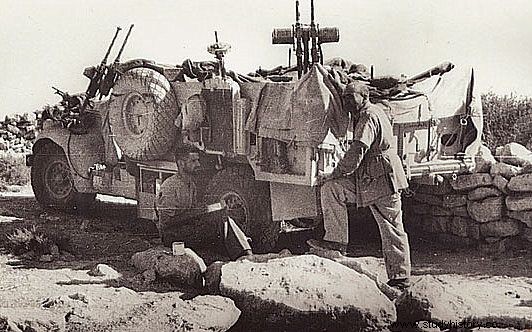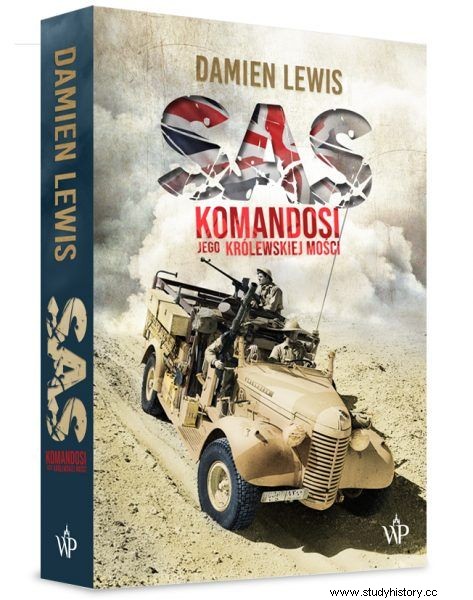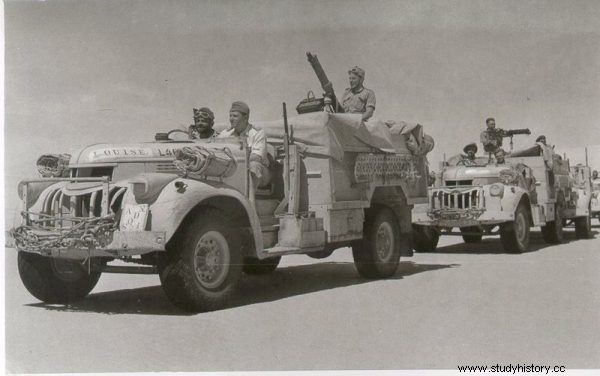"Desert Fox" wrote about them in his journals. Conditions determined by most soldiers as hell were their everyday life. In order to reach their destination, they only needed a solar compass, a stopwatch and maps of pre-war travelers. They replaced the damaged oil pan with a can of canned food, and in their free time they lounged ... under the cars.
As early as June 1940, Major Ralph Angel Bagnold and Lieutenant Guy Lennox Prendergast received permission to create an experimental unit that would initially play a minor role in the war impending on Africa. Before the war, both of them spent almost 10 years exploring the "Black Continent" sponsored by the Royal Geographical Society. Bagnold traversed North Africa in a Ford T, which proved a valuable lesson for action during the war to come. He invented, among others a solar compass, steel gutters to facilitate the excavation of vehicles, a condenser reducing water consumption by a car, but most of all, it marked on the maps most of the wells and oases that so far were known only to nomads. As with most special units, Bagnold only wanted to see in the ranks of his desert reconnaissance people resistant to water shortages, the inconvenience of long-distance desert patrols, persistent and independent. Bloodshot eyes, burnt skin, long beards full of worms and ubiquitous desert sand were to become their everyday life . In return, they received real "people of the desert" for commanders, which of course involved a departure from the barracks routine, meaningless control of made beds, getting up and falling asleep on command. On July 3, 1940, the unit now known as the Long Range Desert Group formally became one of the forces the German and Italian opponents had to reckon with in the region.

Chevrolet LRDG units, on the eve of Operation Caravan, September 1942. Two coupled Vickers K rifles, often also used in air defense, catch the eye.
The life of "ghosts"
The area of operations of the Long Range Desert Group patrol stretched from Cairo to Tripoli, with a full size of 1,600 km by 1,900 km (almost the size of India!). One of the basic advantages of the unit was to be speed in navigating the desert. In a seemingly comical way, they slimmed down their vehicles by depriving them of windows, roofs and doors. As a result, the machines rarely exceeded 1.5 tons, and the only load was the soldiers, supplies and spare parts. The latter, however, were often of an improvised nature. The cracked crankshaft housing was "patched" with a mixture of chewing gum and sand, and in place of the oil pan, properly patched cans of preserves or fruit were often soldered . More often than helmets or hats, they put a kaffiyeh or a woolen cap (so-called cap comforter) on their heads. The best or often the only shade was lying under the car. In the book "SAS. His Majesty's Commandos ”Lewis quotes:
You're just not hot. You don't just feel tired. You feel like all the energy has leaked out of you, your brain wants to jump out of your head. You want to lie still until that damned sun goes down (...) You look at your watch at 11.00. You look back in an hour and it's 11:15
After entering the desert areas, LRDG soldiers switched to rigorous water rationing. Everyone was entitled to just a few pints a day of drinking water, and the total amount of water for one soldier never exceeded one gallon. This allocation was also often used to replenish water in car radiators. Very rarely was it boiled on this water, and even more rarely, the soldiers performed ablution. Dishes and cutlery after meals were more often cleaned with coarse sand than with life-giving water. After a few weeks of patrol, they looked nothing like the same people. The beard very quickly became the hallmark of LRDG soldiers. The rules of the reconnaissance troops seemed far from humanitarian, but at the same time they were the only key to survival in these conditions.

Can desert reconnaissance do more?
In August 1942, LRDG troops under the command of Captain Lloyd Owen were to depart from Cairo to Al-Kufra oasis, the assembly point for a maximum covert operation. After passing the city limits, one of the convoy's vehicles turned off the road and headed for the Cheops pyramid. Like the armies of Caesar or Napoleon, Owen's soldiers also felt the need to pay tribute to the ancient civilization, although the method of execution was slightly different from the Roman or French legions. The driver started the first round around the monumental tomb while the rest of the soldiers pulled out signal pistols (Italian Kimar Vera) and then started firing colorful volleys. They managed to circle the building at least several times, illuminating it in various ways, when suddenly they were stopped by the gendarmerie demanding explanations. The gendarmes received explanations from the driver who was clearly upset by the fact that the game was interrupted. Under normal circumstances, Owen and his men would have ended up in a penitentiary at best, but after a brief and very general explanation of the LRDG's destination, the gendarmes released the patrol. From the summer of 1940, Winston Churchill strongly supported various types of special forces created within the British army, therefore the gendarme eventually had to turn a blind eye to the open disregard of military discipline for the LRDG soldier who, using state equipment, organized a cowboy party close to the front line . The very idea of "decorating" the pyramids shows the scale of stress that a particular member of the desert patrol had to deal with on a daily basis. The fear of being detected by an enemy plane built up a huge level of adrenaline, seeking an outlet in seemingly simple entertainment.
"Romance" LRDG and SAS
In late 1941, SAS and LRDG officers met at the Stephard's Hotel in Cairo. It was a completely accidental meeting, but its effects were supposed to bring interesting cooperation. The officers, influenced by a friendly conversation about the possibilities of both units, decided to undertake a joint mission. On December 8, 1941, a combined force of commandos and desert reconnaissance departed from the Gialo oasis (960 km west of Cairo), whose destination was the town of Tamet. They got there on December 14, finding Italian pilots not suspicious of anything, engrossed in conversation and having fun in the canteen. While the canteen door was breached and a series of tommy guns sounded through the room, planes began to explode at the nearby airport. For the next four days, commandos ravaged local pubs and airports in the most brazen way, blew up planes, killed Italians . As a result of this first scalp of the combined LRDG and SAS forces, the Axis forces hit 24 planes at Temet, 30 planes at Mersa Brega, 37 planes at Agedabia, and on Christmas this year blew up planes again at Temet airport (27 machines) that had just left production line.

LRDG trucks on patrol
The price of betrayal
Over the next six months, the soldiers of David Stirling (commanders and creators of SAS) with the participation of the LRDG similarly harassed the enemy along the entire coast of North Africa, but in May 1942 the SAS received another offer of cooperation. The command planned to weaken Axis aviation capabilities in the Mediterranean Sea so that 17 supply ships could reach besieged Malta. For this purpose, the combined forces of LRDG, SAS and SIG (Special Interrogation Group) were to enter several airports in the Derna-Martuba area. The key of the entire operation was to be the latter formation, founded by Captain Herbert Buck, who had escaped from captivity at El Gazala a few months earlier and, thanks to the captured Afrika Korps cap, was breaking through enemy lines. Buck's soldiers were tasked with introducing the "captives" - SAS commandos to the areas of selected airports. The seemingly perfect plan was full of unknowns. First of all, the SIG agents did not know the June identification slogan for the checkpoints (the May slogan was "fiume", but in the face of more meticulous controls it was useless). Herbert Buck also insisted on the operation of two "inverted" agents, former Afrika Korps soldiers (some Bruckner and Essner). Rommel's cryptologists, who broke the black code a few months earlier and intercepted a cable to Washington, in which the liaison officer expressed full optimism for the war in North Africa, also learned about the action of saboteurs planning to attack the airports in the Derna-Martuba area. Both Stirling and Buck weren't about to abandon the operation. On June 13, two trucks set off towards their goals. In the truck going to Derny there was a traitor, Bruckner, who kept his opponent informed about his position. 200 meters from the police station in front of the airport, he stopped the car under the pretext of a breakdown, and shortly afterwards they were attacked by the Germans. From the group of SIG and SAS agents, only Lieutenant Augustin Jordain survived, who then traveled several dozen kilometers in the desert to meet the LRDG team that was to take them home. Although the remaining SAS units that night destroyed some 27 more enemy aircraft, this did not really affect the protection of Malta by the Axis air force. However, it was a clear message to Erwin Rommel from the British. The time of "fair war" was almost over. Tobruk was now to be the new target for SAS, LRDG, SIG and SBS.

